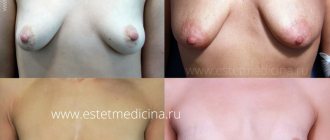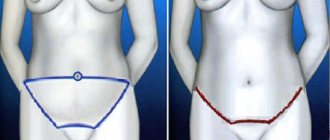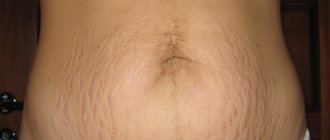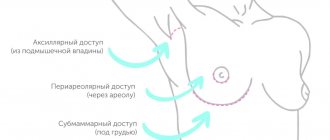Breast augmentation surgery before or after childbirth?
There are no contraindications for breast augmentation before childbirth. However, during consultations, I always recommend that girls have surgery AFTER pregnancy and breastfeeding. When the family is formed and the patient does not plan to have any more children. This will guarantee a stable result - maintaining the shape of the mammary gland.
It is important to understand that all natural processes - pregnancy, lactation, weight changes (weight gain, weight loss) are reflected on the breasts. Both natural and with installed implants.
Will the bust retain its ideal shape after childbirth and breastfeeding? The question is individual. Much depends on the girl’s genetic characteristics: skin density, ability to regenerate, initial state of the gland, etc. Therefore, there is a possibility of a change in the shape of the gland and the need for subsequent correction.
I am familiar with the situation: I had breast surgery and became pregnant. But I can assure you that there is nothing wrong with that. I have a patient who gave birth to two babies after mammoplasty.
Mammoplasty before birth
During pregnancy and breastfeeding, doctors prohibit surgery because it is dangerous for both the mother and the unborn baby. If you plan surgical intervention before pregnancy and childbirth, you should be aware that sometimes after breast augmentation, damage to the milk ducts is possible, which subsequently affects the possibility of natural breastfeeding. This phenomenon occurs extremely rarely; you can play it safe if you choose submammary or axillary types of access, or lipofilling.
Lipofilling does not have these disadvantages due to the low invasiveness of adipose tissue injections. This method of breast augmentation before childbirth is chosen by women who have a sufficient amount of biomaterial for augmentation. The procedure must be repeated, since with significant fluctuations in weight, some of the fat cells may be absorbed, which will lead to a decrease in breast volume.
Augmentation mammoplasty damages the mammary glands when using a periareolar approach (an incision is made near the nipples). Such breast plastic surgery is performed less and less frequently before pregnancy due to high tissue trauma. Axillary and submammary incisions are preferred.
There is a difference in the placement of implants: under the mammary gland, under the pectoral muscle. The first method leads to damage to the milk ducts and the tissue itself. In the second case, the gland is not affected at all.
Reduction mammoplasty is aimed at reducing the size of the organ and involves partial removal of the mammary gland. In this case, breastfeeding may not take place or may have serious complications.
With mastopexy, the breast glands are not affected by the surgeon; the lift is carried out by excision of excess skin. The method will be the best option for breast surgery after breastfeeding.
When choosing an operation, you should discuss the planning of the baby and the type of feeding with your doctor in advance. Surgery is performed at least 6 months before pregnancy so that the patient’s tissues and body have time to recover.
Features of breast augmentation before childbirth
If a girl has not given birth, but wants to have mammoplasty, there are no plans for pregnancy, and, of course, there are indications for surgical intervention, I always use a gentle technique:
- installation of small volume implants;
- complete preservation of the milk ducts.
Modern surgery offers safe breast augmentation - a “sutureless technique” (installation of implants using axillary access - through the armpit), self-absorbing sutures. Patients recover quickly and can return to work in a few days.
Pregnancy and breastfeeding
During mammoplasty, the mammary gland is not exposed or almost not exposed, so the implant does not interfere with breastfeeding and lactation. During pregnancy, a woman's breasts often change their size and shape, but previous breast augmentation surgery using an implant does not have any negative impact on this natural process. Although such an operation is not a contraindication, it should be remembered that pregnancy and subsequent breastfeeding may sometimes require additional correction of previously performed mammoplasty, such as a breast lift (breast mastopexy).
Breast augmentation after childbirth
Restoration of lost forms occurs with the help of breast plastic surgery. To create the ideal shape, you may need both breast augmentation and breast augmentation with additional lifting. All nuances are discussed individually during consultation.
I recommend visiting a plastic surgeon 6 months after breastfeeding is completed, when the bust has taken its final shape. Then the specialist will be able to select the necessary technique. To get a wow effect, I recommend combined operations for young mothers - one-stage bust plastic surgery and tummy tuck (abdominoplasty).
Breast Augmentation: Frequently Asked Questions
Question: What happens to implants during and after pregnancy and is it dangerous to breastfeed a child after implants are installed?
Answer: Unfortunately, it is impossible to give a clear answer to how your breasts will change after childbirth. Each organism is individual, and pregnancy proceeds differently for everyone, leading accordingly to various changes. Typically, breasts increase in size after pregnancy. How much breast enlargement will occur with implants installed depends both on the size of these implants and on the characteristics of the individual woman’s body.
If breast augmentation surgery was performed without stopping the milk ducts (which only happens when using the trans-nipple method of access), then the woman retains the opportunity to breastfeed her child and, as studies show, silicone implants do not have a negative effect on the milk and health of the child.
Question: Do breast augmentation implants need to be replaced over time?
Answer: The implants themselves used for breast augmentation do not have any expiration date and cannot be replaced. Re-intervention is required in rare cases when the implant causes discomfort or is damaged in some way.
Question: I would like to have breast augmentation surgery and lose 5-7 extra kg. My doctor says that first I need to lose weight, and then go for surgery. Why?
Answer: The doctor is right, at the time of enlargement surgery you should be in the shape that you plan to maintain in the future. Weight changes will change not only the proportions of the body, into which, by the way, the new breast may not “fit”, but also the condition of the tissue: the breast may sag, decrease in size, or, conversely, increase in size.
Question: Is breast augmentation possible?
Answer: If you have already had your breasts enlarged, but for some reason you want to change its size, then it is possible to undergo breast augmentation for the 2nd time. The essence of the operation will not change, just before installing a new implant, it will be necessary to remove the old one. However, the feasibility and feasibility of breast augmentation will need to be discussed with your surgeon and the decision made based on their opinion.
Question: At what age can you no longer have breast augmentation surgery?
Answer: Breast augmentation does not imply age restrictions; rather, the general state of health, tissues, skin, the presence of chronic diseases, etc. is important. What is possible for one woman at 50, is contraindicated for another at 45.
Question: Is silicone in implants safe?
Answer: Additional studies aimed at studying the impact of implants on the body have confirmed that silicone gel in no way increases the risk of cancer and other breast diseases, does not affect the course of pregnancy, the development of the baby in the womb and breastfeeding. In addition, the shell of modern implants is multi-layered, which prevents the gel from sweating, and the silicone itself has a consistency that prevents the gel from spreading even if the implant is damaged.
Question: When can I exercise again after breast augmentation surgery?
Answer: On average, the rehabilitation period is 4-8 weeks; after this period, women, as a rule, return to their normal lives. But specifically in the case of physical activity, you should not rely on the advice of “experienced” people or information from any sources. The only person who knows when you can return to the gym is your doctor.
Limiting physical activity is due to several reasons.
Firstly, sweat, which is actively produced during sports, is very harmful to postoperative sutures. This is what is associated with limiting not only physical activity, but also exposure to the sun.
Secondly, surgery is always stressful for the body. And even if you no longer feel it, the body needs time to recover. Don't overload yourself with any physical activity (and we're not just talking about sports here), especially if you need to use your upper body. This, by the way, will also speed up the process of eliminating swelling.
Thirdly, after playing sports you simply need to take a shower, and getting water on the seams in the first 10-14 days is undesirable.
The maximum physical activity in the first weeks after surgery is leisurely walking, which will improve blood circulation.
Question: When can I start tanning after breast augmentation surgery?
Answer: Neither the sun nor the solarium harms the implant itself, but postoperative scars may darken noticeably, so while staying on the beach in the first year after surgery, it is worth protecting the scars from sunlight. In addition, you should avoid visiting the beaches until the scars are completely healed, because... It is undesirable for sweat to get on them. Something else worth knowing about sun exposure is that the implant also heats up in the sun, just like your body, but it cools down much more slowly.
Question: Is it possible to wear an underwire bra after endoprosthetics?
Answer: It is possible, but not earlier than 20 days after the operation. This is due to the fact that the underwires of the bra put pressure on the scars, which can lead to their irreversible deformation.
Do I need to change implants after breastfeeding?
No! The modern implants that we use in the clinic are installed for life and have a lifetime guarantee. A girl can lead an active life with them - skydiving, diving. They are changed only at the request of the patient. Let's say a girl wanted to change the volume of her mammary gland. Then correction is possible - replacing the implants with larger ones.
To make an appointment with plastic surgeon Svetlana Rabotenko, just contact the administrator by phone: +38(096)214-03-33, or leave an online request for a call back.
What is breast augmentation and how long does the result last?
This procedure aims to improve the appearance of breasts using implants by adding volume and reshaping women's busts. Breast augmentation is often performed in conjunction with breast lift surgery.
For young patients who are likely to become pregnant in the future, it is very important to consider how long the implants will last. Since plastic surgery is constantly improving, offering more reliable and high-quality materials every year, we can safely say that breast implants will last at least ten years with proper care.
Can you breastfeed with implants?
Our answer is yes. Breast augmentation does not prevent patients from maintaining the ability to breastfeed. However, according to the International Center for Disease Control, it is likely that the procedure may damage the nerves and ducts inside the mammary glands and thus affect the amount of milk produced.
Results before and after breast prosthetic implantation from the Mentor campaign. You can watch the video at the end of the article to see how the procedure goes.
Can you breastfeed after a breast lift?
And again yes. However, experts warn that there is an increased risk for subsequent breastfeeding after a breast lift, since it involves removing excess tissue and rearranging breast tissue. The operation can significantly affect the production of breast milk, so most patients choose a breast lift after the birth of children, without planning another pregnancy.
The photo shows the result of a breast lift, a seam around the nipple and in the center of the mammary gland









